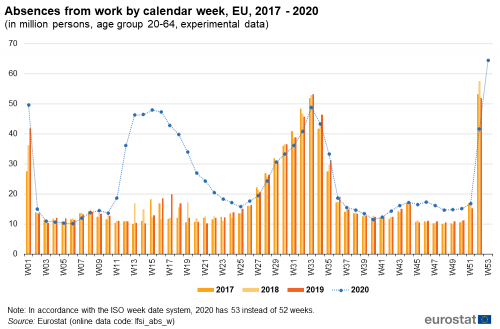Archive:Weekly absences from work
Data extracted in January 2021
Planned article update July 2021
Highlights
To respond to the need for a more thorough analysis of the labour market situation during the recent COVID-19 pandemic, Eurostat developed an experimental indicator “Weekly absences from work”. This indicator focuses on employed persons who are temporarily absent from work in a reference week.
This article presents the main results from this indicator and complements the article Absences from work - quarterly statistics. Both articles are part of the publication Labour market in the light of the COVID-19 pandemic.
The current version of the article focuses on the first three quarters of 2020 (weeks 1 to 39). In April 2021, the article will be reviewed and data on the fourth quarter of 2020 (weeks 40 to 53) will be added in order to present data on the whole year 2020.
Full article
Weekly absences from work spiked in April 2020
In the EU, weekly absences from work usually peak in weeks 1, 33 and 52 of the year, corresponding to early January, mid-August and late December (see Figure 1). However, after the first week of March 2020 (week 10), weekly absences sharply increased because of the first confinement measures taken by governments against the spread of the COVID-19 pandemic. In detail, weekly absences steeply increased from 13.2 to 45.4 million from early to late March 2020 (weeks 10 to 13). The increase continued over the first and second week of April 2020 (weeks 14 and 15), when 45.7 and 47.5 million people respectively were absent from their jobs. For a benchmark, the number of people absent from work in the second week of April represents more than 90 % of the previous peaks in late December 2019 (week 52, 2019) and early January 2020 (week 1, 2020), when 51.9 and 50.2 million people respectively were absent from work.
Figure 2 compares absences from work in the EU in the first 39 weeks of 2020 with the average of the corresponding weeks in the period 2015-2019. It is visible that the number of weekly absences from January to early March 2020 (weeks 1 to 10) was similar compared with the previous years. Even though the number of absences for week 1 of 2020 (30th of December 2019 - 5th of January 2020) was much higher than the average over 2015-2019, it was still below the maximum (so far) for this week, which was recorded in 2015 (50.2 million in 2020 versus 54.2 million in 2015).
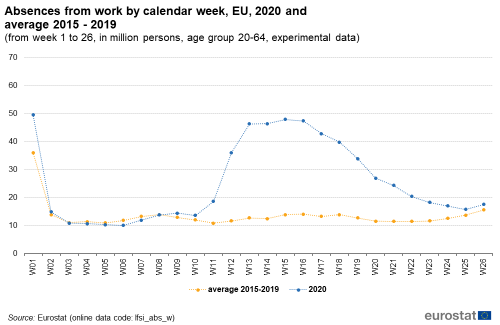
Source: Eurostat (lfsi_abs_w)
From the second week of March 2020 (week 11), absences from work increased substantially. In this week, the number of people absent from work was 4.7 million more compared with the previous week (week 10, 2020) and almost two thirds more (+64.6 %) compared with the average number of absences for the 11th week during the previous years (average 2015-2019). The growth was even more important in weeks 12 and 13, corresponding to mid and late March 2020, where the number of absences went up by 18.1 and 9.4 million respectively. In April 2020, the increase continued, although not so rapidly as for the previous two weeks, with +0.3 million for the first week of April (week 14) and +1.8 million for the second week of the month (week 15). In the following week (week 16), the number of people absent from work slightly declined, with -0.1 million. Nevertheless, the number of weekly absences from work was exceptionally high (47.4 million) in comparison with the previous years (14.1 million) in that week (week 16), as it was the case in the last week of March and the first two weeks of April 2020 (weeks 13-15). In these four weeks (weeks 13-16), the number of absences in 2020 was around three and a half times more than the average over 2015-2019. The gap between 2020 and the previous years was the widest for the first week of April (week 14), when absences from work amounted to 45.7 million in 2020, compared with 12.5 million over the previous years.
From mid-April 2020 (week 16), absences from work took a downward path. However, their decrease was not as rapid as their increase. On average, weekly absences decreased by 4.2 million per week until mid-May 2020 (week 20), when their number reached 26.6 million. This number was, nevertheless, still more than twice as the average number recorded for the 20th week of the previous half-decade, which was 11.6 million.
During the following five weeks (weeks 21-25), the number of people absent from their jobs continued to decline. A more moderate decline of 2.2 million absences per week, on average, took place this time. Absences from work reached 15.5 million in mid-June 2020 (week 25), which was the lowest level after the expansion in March 2020. However, this number was still 1.8 million more compared with the average number of absences for the 25th week during 2015-2019, and also 2.3 million more compared with early March 2020 (week 10).
In the last week of the first half of 2020, namely the week spanning the end of June (week 26), the number of people absent from work increased again, this time with 2.0 million in comparison with the previous week, and reached 17.5 million. For reference, the average number of absences for the same week during the previous years was 15.6 million.
From the beginning of July to mid-August 2020 (weeks 27-33), the number of weekly absences continued its upward path. Its evolution however followed a similar pattern as in the previous years, although a bit milder: the number of absences during these weeks in 2020 was lower than the average over 2015-2019. Especially, at the beginning of August 2020 (week 32), 40.6 million people were absent from work while on average 46.4 million were in this situation in the corresponding week of 2015-2019.
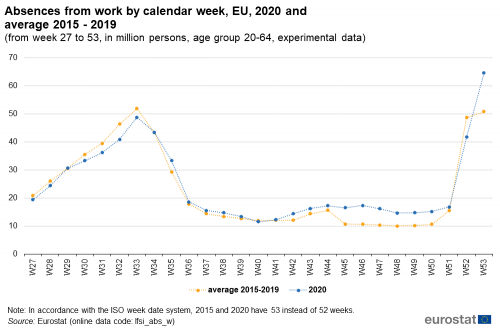
Source: Eurostat (lfsi_abs_w)
Alike the previous years, after its peak in week 33, the number of weekly absences in 2020 began to decline towards the end of September. Nevertheless, the 2020 downward path was also milder than in the previous years, leading to more absences in 2020 than over the period 2015-2019 for each of the weeks 34-39. More tangibly, 32.8 million people were absent from work in the last week of August 2020 (week 35) whereas the average over the previous years for the same week was 29.2 million.
Impact of the COVID-19 crisis on the gender distribution of weekly absences
In this section of the article, the focus is on the ratio between men and women absent from work in the first 39 weeks of 2020. Figure 3 presents a comparison of this ratio with its average for the last five years (2015-2019). A ratio of 100 % suggests a gender equilibrium, whereas a ratio above this threshold implies that men were preponderated among people absent from work (a ratio below 100 % corresponds to an over-representation of women among people absent from work).

Source: Eurostat (lfsi_abs_w)
The "men to women" ratio for the first week of 2020 was 107.0 %, slightly more than the 2015-2019 average for the same week, which was 106.7 %. In other words, there were 7.0 % more male than female absences from work in the first week of 2020, while there were on average 6.7 % more men absent from work than women for the same week over the years 2015-2019.
All in all, up to early March 2020 (week 10), the "men to women" ratio for 2020 went down, closely following the average for the previous five years. More precisely, from 107.0 % in the first week of 2020, it dropped to 82.8 % in the second week of the year. Hereafter, it continued to gradually decline (with the exception of week 8) and reached its lowest point for 2020 in early March (week 10), when the "men to women" ratio accounted for 66.5 %, meaning that men were with one third less than women (-33.5 %) among the group of people absent from work in week 10.
From the second week of March 2020 (week 11), alongside with the outbreak of the COVID-19 pandemic, the "men to women" ratio started to increase steeply. The development of this ratio in March 2020 was the following: from 66.5 % in its beginning (week 10) to 96.5 % by its end (week 13). In the first week of April 2020 (week 14), the number of men exceeded the one of women among people absent from work. The "men to women" ratio for this week amounted to 102.9 %. Indeed, during this week, marked by one of the greatest peaks of total absences in 2020 so far, the number of men absent from work was 23.2 million, whereas the corresponding number for women was 22.5 million. From the first week of March 2020 to the first week of April 2020 (weeks 10 to 14), male absences rose by 17.9 million, compared with an increase of 14.6 million for women. For reference, the average number of men and women absent from work for week 14 during the previous five years was 5.3 million and 7.2 million respectively, corresponding to an average "men to women" ratio of 73.6 %.
After its peak in early April 2020 (week 14), the "men to women" ratio decreased to levels below 100 % and gradually declined over the weeks up to the end of June 2020 (week 26), when it reached 77.4 %. Nevertheless, for the whole period from week 11 to week 26 2020, the "men to women" ratio was above its average over the previous five years. Most prominently, from mid-March to end April 2020 (weeks 12 to 17), the "men to women" ratio was more than 20 percentage points (p.p.) higher than the average for 2015-2019. The greatest difference can be observed for week 15: the "men to women" ratio for this week in 2020 reached 98.9 % while its average for this week during the previous five years only amounted to 69.4 % (29.5 p.p. difference).
The decline of the “men to women” ratio continued during the first week of July 2020 (week 27), when it reached 71.5 %. However, from the second week of July 2020 (week 28), it started to increase again, and the increase followed this time a similar pattern as in the previous years. The rise reached its peak in the penultimate week of August 2020 (94.1 % in week 34), after which the ratio started to decrease again, similarly to the previous years, and dropped to 77.0 % in the last week of September 2020 (week 39). For reference, the 2015-2019 average of the “men to women” ratio for the 34th and 39th week was 92.3 % and 77.4 % respectively.

Source: Eurostat (lfsi_abs_w)
Disparities among countries of the COVID-19 impact on weekly absences
The objective of this part of the article is to illustrate the situation in regard to weekly absences from work across European countries. Indeed, as the timing and strictness of the COVID-19 containment measures differ between countries, it can be expected that the effects on weekly absences would vary from week to week and from country to country.
A separate graph is presented for every country with information available for more than 50 % of the weeks in the period 2015-2020. Each graph contains information about the level of absences from work for every calendar week from the first to the 39th week of 2020, as well as the average of the number of absences recorded for the same sequence of weeks during the period 2015-2019. In order to visualize more accurately the wide distance between the lowest and the highest values, every graph is produced both in linear and in logarithmic scale. The graphs with their accompanying data can be found ![]() here.
here.
Greece, Romania and Cyprus were the EU Member States recording the largest increase in the number of absences from work. In these countries, the number of employed people who were absent from work during the first nine months of 2020 was the most persistently higher than the number recorded over the previous years (average 2015-2019).
The increase in weekly absences was the highest in Greece. Over eleven weeks during the first nine months of 2020, from mid-March (week 12) to the last week of May (week 22), the number of people absent from work in this country was at least nine times higher than in the corresponding weeks in the previous years (see Figure 4). Moreover, 14 to 19 times more people were absent from work in Greece in the last week of March 2020 (week 13) and during the first three weeks of May 2020 (weeks 19 to 21) than in the same weeks of 2015-2019.
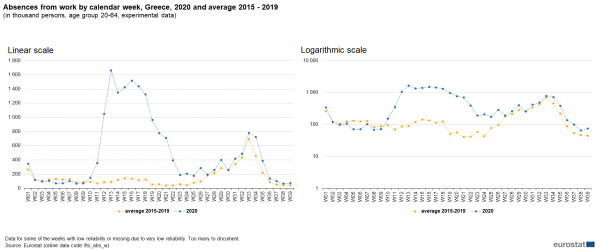
Source: Eurostat (lfsi_abs_w)
In June 2020 (weeks 23 to 26), the number of absences in Greece reduced the distance with its average recorded during the past half-decade. Nevertheless, the values were still far from recovery, as the number of absences in June 2020 was still three times (in weeks 23 and 26), and even five times (in week 24), higher than in the previous years.
During the period from July to September 2020 (weeks 27 to 39), the number of absences in Greece, albeit higher, followed a similar development as in previous years. However, the percentage difference between the value for 2020 and the average over 2015-2019 began to widen after the 33rd week and was the widest for this period in the 35th, 37th and 39th week. In those weeks, the number of absences in 2020 was 74.6 %, 88.2 % and 65.4 % resp. higher than the corresponding 2015-2019 average.
Following Greece, Romania and Cyprus were the second and third EU countries where the number of weekly absences from work increased the most severely in the first nine months of 2020. These two countries recorded during March, April and May at least five times more absences from work in 2020 than the average over 2015-2019 (Romania: from week 13 to week 22, and Cyprus: from week 12 to week 22). Moreover, in Romania, in April and early May (weeks 14-18 and 19, 2020) absences from work exceeded 9 to 17 times their values from the past five years. In addition, in Cyprus, the number of weekly absences in late March, early April, mid-April and the first two weeks of May (weeks 13, 14, 16, 19 and 20 of 2020) was 9 to 13 times higher than in previous years.
In June 2020, the number of absences in Romania and Cyprus began to approach the number recorded over the previous years. Then, during the period July-September 2020 (weeks 27-39), absences followed the same pattern as in previous years, although with some fluctuations. Few weeks in Romania deviated more significantly, namely weeks 29 and 35, corresponding to mid-July and late August 2020, when people absent from work were twice as many as the average over 2015-2019.
All Member States with available data experienced an increase in the number of weekly absences over the first nine months of 2020 in comparison with the previous years. However, this increase was smaller in some countries, for example in Finland and the Netherlands. The example of the Netherlands is shown in Figure 5.
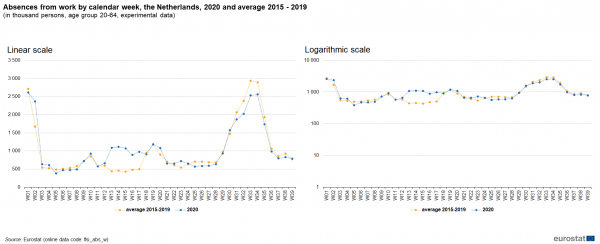
Source: Eurostat (lfsi_abs_w)
In the Netherlands, the number of people absent from work during the first half of 2020 increased rather moderately in comparison with the other Member States. Moreover, after the outbreak of the COVID-19 pandemic in Europe in spring 2020, the number of absences was substantially higher than the number recorded over the previous years only for a short period, significantly shorter than for the other Member States. Indeed, this was the case only in the five weeks from the end of March to the week before the last week of April 2020 (weeks 13 to 17), when people absent from work were around twice as many as during the previous years. After its peak in the first week of April 2020 (week 14), the number of weekly absences in the Netherlands began to decline towards the end of April 2020 (week 18), when it came back close to its average values of 2015-2019, and then continued to follow the pattern from the previous years. From mid-June until the end of September 2020 (weeks 25 to 39), the number of weekly absences was similar to the corresponding 2015-2019 average, being even slightly lower for the vast majority of the weeks.
Source data for tables and graphs
Data sources
All figures in this article are derived from the European Union Labour Force Survey (EU-LFS).
Source: The European Union Labour Force Survey (EU-LFS) is the largest European household sample survey providing mostly quarterly and annual results on labour participation of people aged 15 and over as well as on persons outside the labour force. It covers residents in private households. Conscripts in military or community service are not included in the results. The EU-LFS is based on the same target populations and uses the same definitions in all countries, which means that the results are comparable between countries.
European aggregates: EU refers to the sum of EU-27 Member States. If data are unavailable for a country, the calculation of the corresponding aggregates is computed with estimates. Such cases are indicated.
Coverage: Data are not available for Sweden for the whole time series (2015 – Q3 2020), as well as for Germany for 2020 (see below).
Country note: In Germany, from the first quarter of 2020 onwards, the Labour Force Survey (LFS) is part of a new system of integrated household surveys. Unfortunately, technical issues and the COVID-19 crisis has had a large impact on data collection processes, resulting in low response rates and a biased sample. For this reason, additional data from other integrated household surveys has been used in addition to the LFS subsample, to estimate a restricted set of indicators for the first three quarters of 2020, for the production of LFS Main Indicators. These estimates have been used for the publication of German results, but also in the calculation of EU and EA aggregates. By contrast, EU and EA aggregates published in the Detailed quarterly results (showing more and different breakdowns than the LFS Main Indicators) have been computed using only available data from the LFS subsample. As a consequence, small differences in the EU and EA aggregates in tables from both collections may be observed. For more information, see here.
Definitions: The notion of temporary absence from work refers to situations in which a period of work is interrupted by a period of absence. This implies that persons are generally to be considered as having been temporarily absent from work and therefore employed if they had already worked at their current activity and were expected to return to their work after the period of absence. Persons without work who had made arrangements to take up paid employment or to engage in some self-employment activity at a date subsequent to the reference period, but who had not yet started work, are not to be considered as temporarily absent from work. For more information on absences from work, please consult pages 22 to 28 from the EU Labour Force Survey Explanatory Notes
Also, five different articles on detailed technical and methodological information are available from the overview page of the online publication EU Labour Force Survey.
Context
The COVID-19 pandemic hit Europe in January and February 2020, with the first cases confirmed in Spain, France and Italy. COVID-19 infections have now been diagnosed in all European Union (EU) Member States. To fight the pandemic, EU Member States have taken a wide variety of measures. From the second week of March, most countries closed retail shops apart from supermarkets, pharmacies and banks. Bars, restaurants and hotels have also been closed. In Italy and Spain, non-essential production was stopped and several countries imposed regional or even national lock-down measures which further stifled the economic activities in many areas. In addition, schools were closed, public events were cancelled and private gatherings (with numbers of persons varying from 2 to 50) were banned in most Member States.
The large majority of the prevention measures were taken during mid-March 2020 and most of the prevention measures and restrictions were kept for the whole of April and May 2020. The first quarter 2020 is consequently the first quarter in which the labour market across the EU has been affected by COVID-19 measures taken by the Member States.
Employment and unemployment as defined by the ILO concept are, in this particular situation, not sufficient to describe the developments taking place in the labour market. In this first phase of the crisis, active measures to contain employment losses led to absences from work rather than dismissals, and individuals could not search for work or were not available due to the containment measures, thus not counting as unemployed.
Direct access to
<maintables>
Main tables
<maintables>
